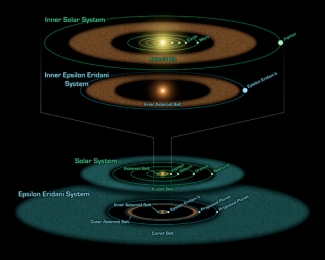Fellow Phil Armitage and colleagues from the Université de Bordeaux and Google, Inc. are key players in the quest to understand the secrets of planet formation. Current theory posits that there are three zones of planet formation around a star (as shown in the figure). In Zone One, the hot innermost zone, small rocky planets form over a period of hundreds of millions of years. The planets form too slowly to accrete gas from the original planetary disk. Zone One is the terrestrial, or habitable, zone.
Zone Two is the region where giant gas planets like Jupiter and Saturn and ice giants like Uranus and Nepture form. The giant planets form quickly and are often closely packed. The close packing can make them violently unstable. Interactions (and collisions) of these planets not only influence the evolution of planets in Zones One and Two, but also the planetoids and debris found in Zone Three.
Zone Three comprises the solar system’s Kuiper Belt and Epsilon Eridani’s comet belt. These zones are filled with debris that didn’t have time to build large objects (i.e., planets) or whose planet building was thwarted by the giant planets in Zone Two. In today’s solar system, the Kuiper Belt contains 10 known dwarf planets, including Pluto, plus millions of smaller objects. The original Kuiper Belt is thought to have been hundreds of times more massive than it is today. Most of the Kuiper Belt’s mass was ejected from the solar system via collisions and other interactions with the giant planets.
Armitage and his colleagues examined the impact of collisions and interactions involving the giant planets in Zone Two. They found that a collision could move giant planets inward toward their star or eject them entirely from the star system. They concluded that the ultimate fate of an entire planetary system appeared to depend on interactions of the closely packed giant planets, whose gravitational influence dominated everything else. These planets were also affected by the primordial Kuiper disk, which helped to separate them and stabilize (and possibly recircularize) their orbits after an early period of instability and collisions. According to Armitage, the unstable period of collisions in Zone Two is responsible for what happens to a planetary system’s outer planets. If things are relatively calm, the giant planets will interact with the outer debris disk, gradually widening the space between them and settling into near circular orbits.
In other star systems, collisions can send giant planets spiraling into their star or rocketing out of the star system. They can cause planets to have wildly eccentric orbits, setting the stage for additional crashes. There are many possible outcomes to this early and often violent period, in which ~50% of the giant planets that end up in close orbits around their star will have had at least one collision.
The violent interactions inside Zone Two also affect the terrestrial planets, which grow slowly via collisions with other rocky bodies. If the outer planets are relatively well-behaved, as was likely in the early solar system, then the inner planets are free to evolve, possibly into habitable planets. In contrast, violent collisions in Zone Two can not only eject the giant planets there, but also scour Zone One, ejecting part or all of its rocky material.
With their new understanding of the effect of the interaction of giant planets on a planetary system, Armitage has now turned his attention to Zone One, looking for clues to the formation of habitable planets. He knows that all terrestrial planets form from collisions of smaller bodies. In fact, he says that our moon was likely created in the last large collision with a body the size of Mars that formed the Earth. This suggestion raises the question whether there might have been a fifth terrestrial planet, which formed in the region now occupied by the asteroid belt.
Armitage says there might even have been a fifth giant planet that was ejected early from the Solar System. Perhaps, it’s lurking beyond the Kuiper Belt, where it influences the wildly eccentric orbit of Sedna, a dwarf planet discovered in 2003. However, whether there were once more planets in our solar system is still a mystery to be solved. There is still much to be learned about the planet we call home and others like it. - Julie Phillips



 The Physics Frontiers Centers (PFC) program supports university-based centers and institutes where the collective efforts of a larger group of individuals can enable transformational advances in the most promising research areas. The program is designed to foster major breakthroughs at the intellectual frontiers of physics by providing needed resources such as combinations of talents, skills, disciplines, and/or specialized infrastructure, not usually available to individual investigators or small groups, in an environment in which the collective efforts of the larger group can be shown to be seminal to promoting significant progress in the science and the education of students. PFCs also include creative, substantive activities aimed at enhancing education, broadening participation of traditionally underrepresented groups, and outreach to the scientific community and general public.
The Physics Frontiers Centers (PFC) program supports university-based centers and institutes where the collective efforts of a larger group of individuals can enable transformational advances in the most promising research areas. The program is designed to foster major breakthroughs at the intellectual frontiers of physics by providing needed resources such as combinations of talents, skills, disciplines, and/or specialized infrastructure, not usually available to individual investigators or small groups, in an environment in which the collective efforts of the larger group can be shown to be seminal to promoting significant progress in the science and the education of students. PFCs also include creative, substantive activities aimed at enhancing education, broadening participation of traditionally underrepresented groups, and outreach to the scientific community and general public.